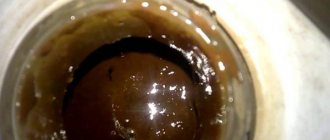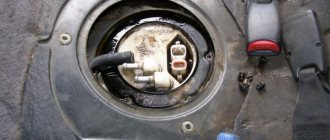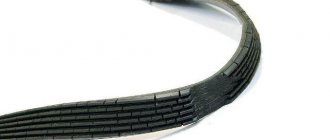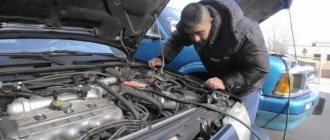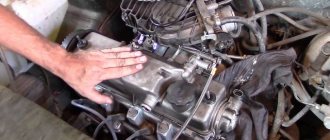A certain failure in the operation of the power unit is characterized by the concept of “the diesel engine has gone haywire.” Such a malfunction is more often a problem with diesel engines, although there have been cases when a gasoline carburetor engine was damaged.
This concept should be understood as an uncontrolled spontaneous increase in engine speed to the maximum permissible values, as a result of which the power unit actually self-destructs after several minutes of operation at the limit.
A similar operating mode can occur both after starting the engine and after a sharp reduction in the load on the engine. Diesel overrun means maximum speed (arrow in the red zone of the tachometer), loud noise during engine operation, which is accompanied by thick smoke and soot from the exhaust pipe, as well as sometimes flashes of flame.
We also recommend reading the article on how to decarbonize a diesel engine with your own hands. From this article you will learn about the causes and consequences of carbon deposits in the engine combustion chamber, as well as available methods for decoking piston rings and removing deposits from the surface of parts.
The consequences of runaway for an internal combustion engine are usually catastrophic: the engine overheats, then the unit jams as a result of overheating or destruction of parts due to increased mechanical loads, the crankshaft breaks, valves, pistons melt, etc. Running a diesel engine is also dangerous because the engine can literally explode, as the connecting rods pierce the cylinder head, break the cylinder block, and fragments fly into the engine compartment. A fire in the engine exhaust tract is also possible.
Characteristic
Sometimes you hear “diesel has gone bad.” What does it mean? Overrun is an uncontrolled increase in engine crankshaft speed, regardless of the position of the accelerator pedal. In most cases, the driver cannot control this process. The crankshaft rotates at high speed, which is constantly increasing.
Sometimes the revs reach 5 thousand. This is dangerous for a diesel engine. This action occurs for several minutes. The result is a jammed power unit. Often accompanied by thick black smoke from the exhaust pipe.
Action plan in case of engine malfunction
Many motorists have already developed a specific action plan that is recommended to be carried out in the event of equipment breakdown.
- If for some reason the engine speed begins to increase sharply, then it is necessary to turn off the ignition and gear. Very often the driver does not always have time to notice the increase in speed. At the initial stage of their growth, it is possible to turn off the engine in the usual way.
- If possible, move to the side of the road;
- If necessary, open the hood to gain access to the air intake;
- It is recommended to turn on the hazard lights;
- The air intake hole must be covered with thick cloth. Truckers use sweatshirts for these purposes. If there is a carbon dioxide fire extinguisher in the car, then use it. The jet is directed into the air intake. Since this gas is not flammable, the powerful flow will cause the engine to “choke,” which will lead to its stop;
- You can no longer start the engine. Otherwise, the car owner will see his engine die. The car is transported to the repair shop either by tow or by tow truck.
If for some reason the driver cannot perform these manipulations, then he should move a short distance from the car and start calling specialized services for help.
If you carry out the above steps in time, this will lead to the fact that only engine repair will be required, and possibly replacement of the turbocharger. However, there will be no other serious consequences.
Experts do not recommend repairing equipment on your own, because the slightest flaw will lead to the situation with the breakdown repeating. It is best to repair a diesel engine in specialized centers. Therefore, you should not skimp on the work of professionals, so as not to pay twice.
Such phenomena still happen during the operation of the car, so owners are interested in the reasons why the engine is running wild. Most of the cases occur in diesel engines, especially those that were produced many years ago. Modern engines, in addition to the driver, are also controlled by on-board computers, which carefully monitor the operating conditions of the power unit, do not give it excess fuel, and do not allow an uncontrolled increase in crankshaft speed.
Reasons - fuel injection pump
One of the main reasons for this phenomenon is a malfunction of the high-pressure fuel pump or rack. As a result, fuel enters the combustion chamber without restrictions. This is an uncontrolled process. And the more of it gets into the chamber, the higher the engine speed. After this, the gas distribution mechanism (often with a chain drive) does not have time to react to these changes. As a result of incorrect phase distributions, the crankshaft, intake and exhaust valves bend. The consequences in most cases are very sad. What to do if the engine breaks down?
There is only one way to save the unit - shut it down. But it is not always possible to do this with a key. You have to independently block the access of air to the combustion chamber. But in some cases, the diameter of the inlet intake hole is very large. And even with improvised means it will not be possible to close it. Air will still flow through small cracks. It is worth noting that on passenger cars the oxygen intake is located at the bottom. Therefore, you will have to cut off the supply after the air filter. To do this, unscrew the clamp with a screwdriver and stop the oxygen supply to the pipe. This needs to be done as quickly as possible. Remember that minutes count here. The second option is longer, but effective. If the engine starts to spin, it is necessary to stop the fuel supply by disconnecting the fuel line. But there is not always time for this. The consequences are bent valves and a failed crankshaft. The worst thing is that at this time fragments of the cylinder block are flying. The explosion can be compared to the effect of a grenade. It is simply dangerous to be near such a motor. But this does not happen immediately, but after 3-5 minutes of engine operation in this mode.
What are the risks if the engine breaks down?
There are two ways the situation could develop. One is dangerous and the other is very unpleasant.
First option. If the engine starts to spin while driving, then the car becomes like an angry metal mustang, it begins to accelerate uncontrollably, which in the worst case can lead to an accident, and here everything depends on the level of driving skill and the instant ability to adequately respond to an extremely developing situation. If the driver is okay with this, then the consequences themselves will not go beyond the bounds of reason.
Second example. If this incident happened in a parking lot/parking lot, that is, precisely when the car is operating in neutral mode, then the engine, having reached its prohibitive speed in an abnormal operating mode, will continue to spin until it stops completely, it will simply fail. Depending on certain conditions, the motor can literally demolish its “tower”, thus tearing off the block head and subsequently scattering all its insides over the immediate surrounding area.
Turbine
Diesel can go bad for a variety of reasons. If it is a turbocharged engine, there is a high probability that this happened precisely because of this mechanism. This element is cooled by oil. Sometimes leaks occur. As a result, the mechanism is unable to provide boost. Engine speed involuntarily increases. As they increase, the oil pump begins to pump lubricant faster. As a result, it ends up in the combustion chamber. Black smoke comes out of the exhaust pipe.
With such a malfunction, the unit may be left without lubrication altogether. After all, all the oil went into the exhaust pipe. There have been cases when, even after turning off the fuel supply, the unit continued to operate purely on lubricant. And even if this process lasts no more than a minute, this is quite enough for the diesel to go to waste. This happens especially often on older military engines. They are designed for the consumption of fuel oil and kerosene. Therefore, you should not be surprised that after stopping the fuel supply, the engine continues to work. If the diesel engine goes into overdrive, the crankshaft may burst in half. It is not necessary that it will tear out the cylinder block and fly out with fragments. In some cases, the engine will continue to operate, but with characteristic knocking noises. What else happens when diesel goes into overdrive? As the speed increases, the engine temperature increases. It overheats quickly. Also, if it is a leak from the turbine, fires are possible in the exhaust manifold area. Piston jamming occurs in a matter of minutes. Moreover, it does not matter what the current inertia force of the flywheel is. Even if the car is idling, the connecting rod bolts and other elements of the crank mechanism (crank mechanism) may break.
Why only diesels?
As practice shows, only the diesel engine is destroyed.
And there are reasons for this. The speed of a gasoline engine is controlled by the throttle valve. It passes a certain amount of air, as a result of which the number of shaft revolutions can be adjusted from 1 to 7 thousand. On gasoline motorcycle internal combustion engines, the maximum mark is 10-13 thousand. As for the diesel engine, its operation is controlled by the amount of fuel, not air. The design of such a unit does not have a throttle valve. Moreover, in order to ignite the mixture, it does not need candles or sparks. Even if you remove the battery, such a motor will continue to work. As for modern diesel engines, they have a much smaller chance of going into overdrive, since the amount of fuel is strictly dosed by injectors.
Here the system is controlled electronically, so if there are problems with the gas pedal, the computer will stop or partially reduce the supply of fuel to the combustion chamber. This usually takes less than a second. Thus, if the diesel goes into overdrive, you do not have to unscrew the fittings and lines yourself, or block the access to oxygen. The electronics will do everything for you, and so quickly that you won’t notice it.
Links
- engine spacing
- article from. - Seifert, Bill.
Offshore Sailing: 200 Essential Passagemaking Tips. —McGraw-Hill Professional, 2001.
Compression ratio of a diesel engine - what is it?
A diesel engine (in common parlance - diesel) is a piston internal combustion engine that operates on the principle of self-ignition of atomized fuel under the influence of air heated during compression. It is used mainly on ships, diesel locomotives, buses and trucks, tractors, diesel power plants, and by the end of the 20th century it became widespread on passenger cars. Named after the inventor. The first engine operating on this principle was built by Rudolf Diesel in 1897.
The range of fuels for diesel engines is very wide, this includes all fractions of oil refining from kerosene to fuel oil and a number of products of natural origin - rapeseed oil, frying fat, palm oil and many others. A diesel engine can also run on crude oil with some success.
The MiG-31 (according to NATO codification: Foxhound - fox hound) is a Soviet and Russian two-seat supersonic high-altitude all-weather long-range fighter-interceptor. Developed at OKB-155 (now PJSC RSK MiG) in the 1970s. The first Soviet combat aircraft of the fourth generation.
The MiG-31 is designed to intercept and destroy air targets at extremely low, low, medium and high altitudes, day and night, in simple and adverse weather conditions, when the enemy uses active and passive radar jamming, as well as false thermal targets. A group of four MiG-31 aircraft is capable of controlling airspace with a frontal length of up to 1,100 km.
Initially, the fighter was developed to intercept aircraft cruise missiles and the then new American B-1 bombers in the entire range of altitudes and speeds, as well as low-flying satellites and automatic drifting balloons (ADA), launched by NATO countries since the 50s over the territory of the USSR.
For several years, the MiG-31 regiments had the status of special forces (SpN) as part of the air defense.
Engine knock occurs during rapid (explosive) combustion of the fuel-air mixture in the cylinder of an internal combustion engine. To the ear it is perceived as a metallic “ringing” or knocking. This is an undesirable mode of engine operation, since increased pressure and overheating occur in the cylinder, and the cylinder structural elements experience increased loads for which they were not designed, engine power decreases, and emissions of harmful substances increase. When intensely applied, these loads quickly lead to cylinder damage and engine failure.
Engine knocking is sometimes called detonation or detonation combustion of the mixture, but this name does not reflect the physics of the phenomenon. Combustion of the mixture in an engine cylinder, both when ignited by a spark and during premature self-ignition of the mixture in hot spots, as a rule, is not accompanied by the formation of detonation waves. In accordance with the amplitude of the pressure waves that occur in the cylinder during rapid combustion of the mixture, a distinction is made between the normal combustion mode (without knocking) and the mode in which knocking occurs. The latter mode, in turn, is divided into conventional knock of varying intensity and detonation knock (super-knock or deto-knock) according to peak pressure values. Detonation knock is especially undesirable, since the pressure generated in the detonation combustion wave can immediately destroy the cylinder.
The occurrence of knocking is associated with the effects of abnormal combustion of the mixture in the cylinder: self-ignition of the mixture before it is ignited by a spark or wall ignition by hot structural elements or foreign particles in the cylinder. The likelihood of knocking increases with increasing compression ratio and engine load, as well as with decreasing fuel octane number. Electronic ignition control systems are used to prevent knocking, and anti-knock additives such as MMA (monomethylaniline) or MTBE (methyl tert-butyl ether) are added to the fuel.
How to avoid malfunction?
To avoid serious consequences, you need to monitor the performance of the injection pump.
An engine equipped with a turbine or compressor should not squirt oil or “eat” it beyond normal limits. The limit is 1 liter per ten thousand kilometers. Timely oil changes and repairs to the cylinder-piston group can reduce the risk of blowout several times. Remember that if the seal is broken, oil will enter the intake tract along with air. This mixture burns much more intensely. Therefore, the turnover will increase. And so on until the oil is completely gone. Crankcase ventilation should also be monitored. If it is poorly sealed, oil vapors enter the intake manifold. When the car's mileage is high, the piston rings are not able to remove all the film. As a result, vapors under pressure from the crankcase penetrate into the combustion chamber. It is impossible to control this process.
Additional pump adjustment
If diagnostics of diesel engines shows that the mixture is not being prepared correctly, most likely the cause is the injection pump, and the centrifugal regulator cannot cope with this function. For this, a special adjustment stand is used.
Before checking, it is necessary to clean the pump from dirt and other deposits. Then the injection advance is checked using marks and the low pressure valve is diagnosed. To do this, you need to unscrew the valve and tap with a hammer (light blows) on its upper part. Next, the cyclic feed is set. It is adjusted using a locknut. If necessary, it is unscrewed or tightened and then clamped. Normal idle speed of a diesel engine is 770-790 per minute. For additional adjustment, use a hydraulic corrector by rotating its rod counterclockwise or clockwise. Timely troubleshooting ensures reliable operation of the power system and the engine as a whole.
